Case Study: How Moov delivered BBC’s virtual Tokyo Olympic studio
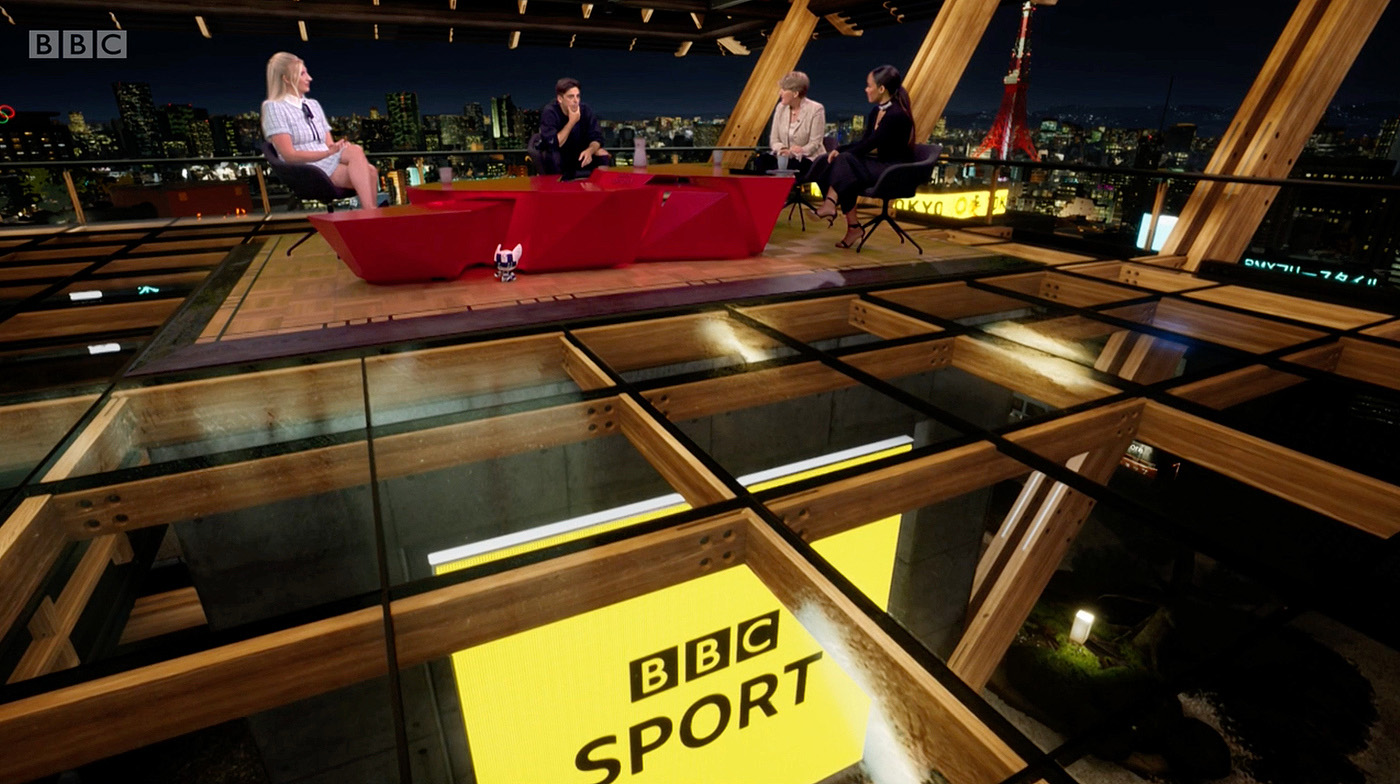
Subscribe to NCS for the latest news, project case studies and product announcements in broadcast technology, creative design and engineering delivered to your inbox.
Moov delivered a ground-breaking Virtual Graphics Production for BBC Sport that raised the ‘industry bar’ to an Olympic level. This project was a massive team effort and involved years of planning, with the result being the proudest achievement of their 21 years in the broadcast.
When BBC Sport started the 2020 Tokyo Olympics coverage project, the initial idea was to do a virtual production from the IBC in Tokyo. Toby Kalitowski (BK Design Projects) and Jim Mann (Lightwell) proposed an iconic location reflecting the ultra-modern and traditional faces of the host city. BBC Sport’s home for the Olympics would be an open-sided timber pavilion in the bustling heart of Tokyo providing multiple presentation areas with graphic innovation at its’ heart.
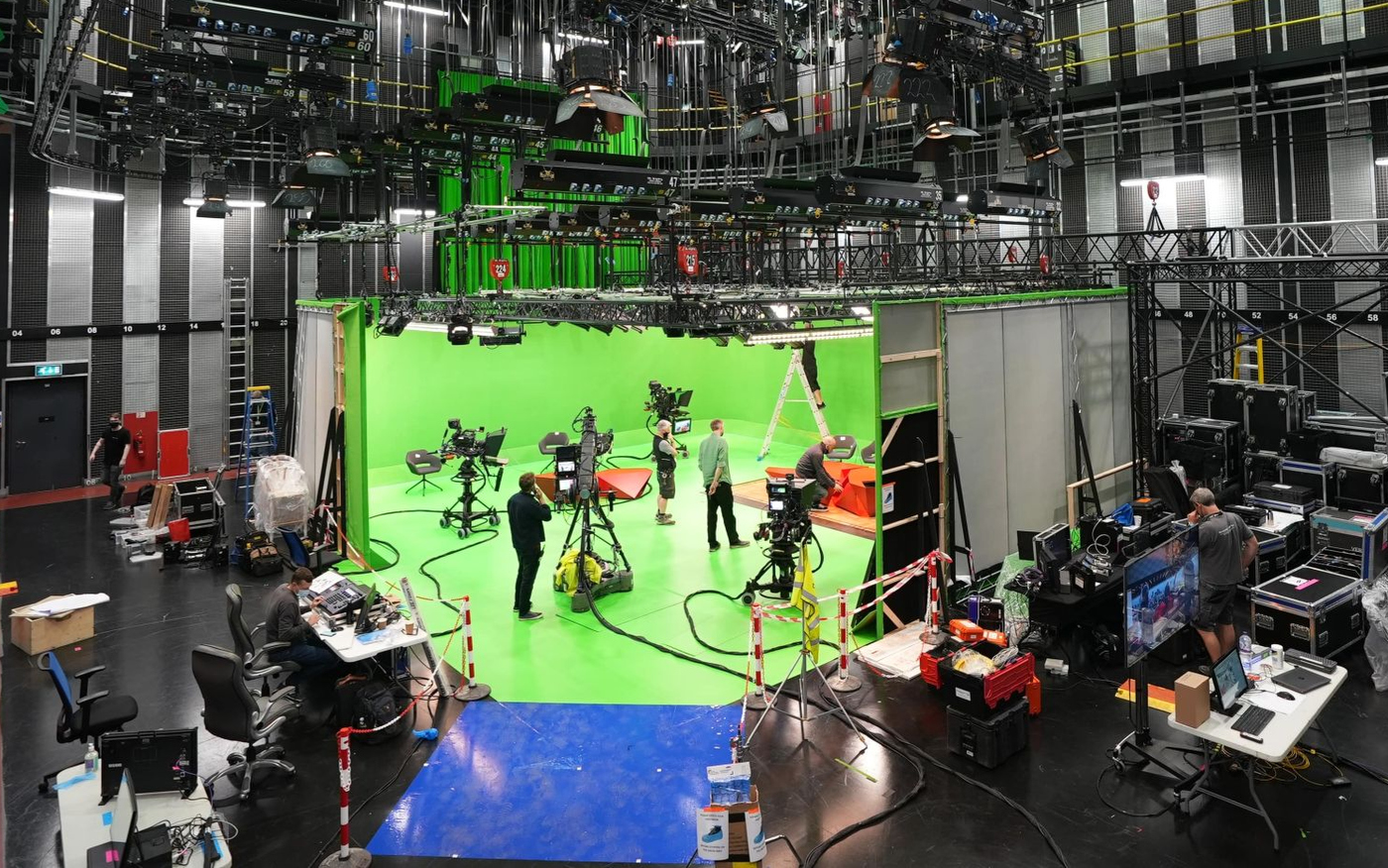
The studio at Dock10.
Alongside the concept stage, Moov were tasked to create the entire graphics and virtual production that would deliver across the 17 days of non-stop coverage. As the pandemic struck, with the doubts on the games even happening, and later the travel and attendance restrictions, the BBC redirected the presentation back to the UK, to Dock10 in Media City, Salford.
The final set design was a multi-layered rooftop virtual studio that would give the production teams a selection of unique spaces to broadcast from, each with optional augmented screens and great views from every angle. Each area had been carefully designed and the attention to detail in the layering was beautiful.
Huge wooden beams, glass floors and a rooftop garden were just for starters. They even had an infinity pool with fish swimming beneath the studio which provided the teams with great fun giving them Olympian fish names!”
There are many graphical parts to this project, however, the build of the virtual studio was going to be the most challenging.
Not only had Moov to build the multi-layered virtual studio design in real-time, but also keying, masking, tracking, graphics, and production control were required to create a virtual 360 city to surround the studio. This would hold graphics, Olympic branding, and video imagery, and being a 24/7 live production, the studio, and everything in the scene, had to work for both the day, dusk and night setups.
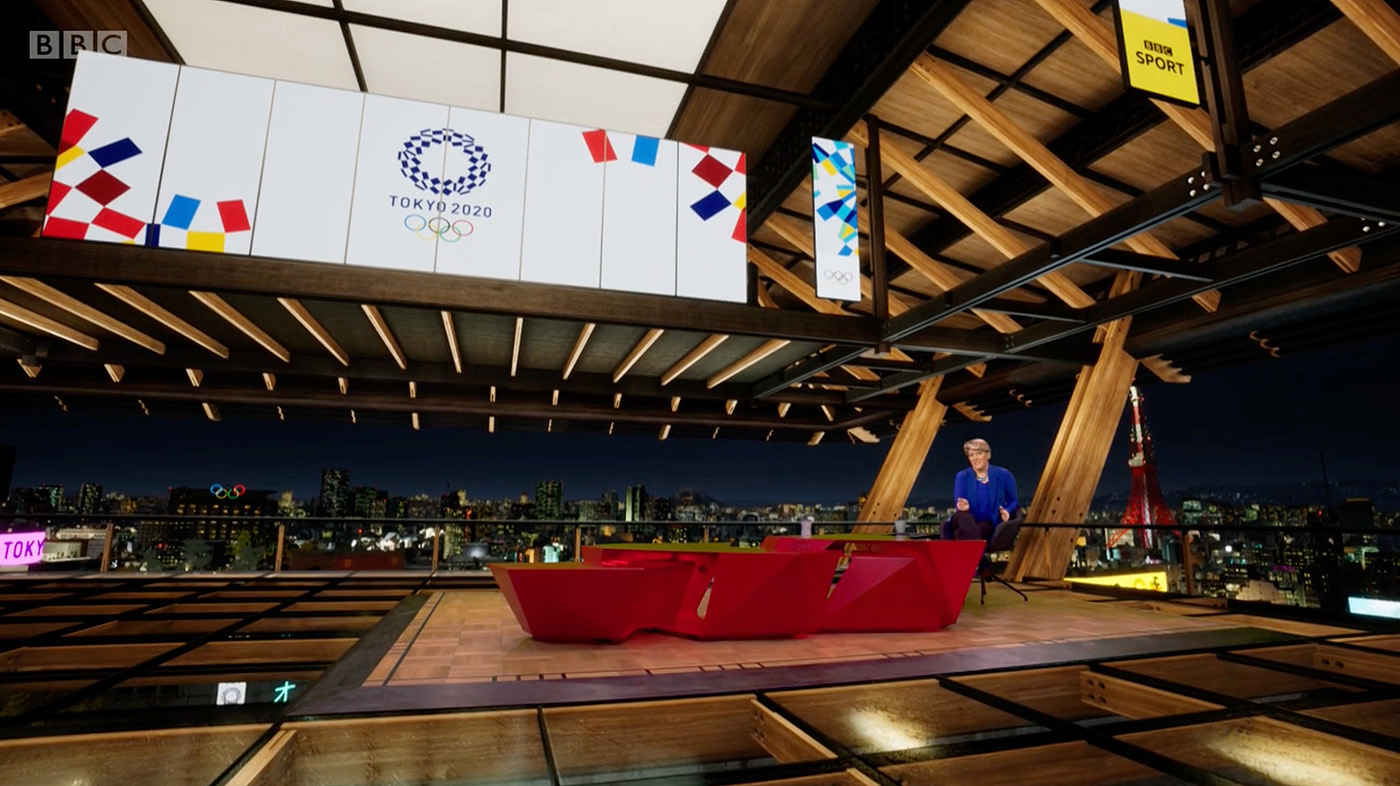

The virtual set design from BK Design Projects and Lightwell.
In addition to the virtual production, the Moov team created an extensive range of on-screen presentation graphics that would help signpost and enhance the coverage. Augmented studio screens in the studio would also show these live graphics and any specially prepared stings or analysis footage.
One of the key aspects of the project was that it had to look amazing, but it also had to work real-time, all the time. By far the most challenging part of this project was implementing the design, optimizing it, and adding live video screens and functionality controls, whilst keeping it all within the parameters of real-time. The city was made up of 100’s of layers, with buildings and assets being positioned to compliment the important presenter singles, something you wouldn’t have the luxury of doing in real life.
The studio floor, with 7 unique positions over 3 levels, each with its own detailed camera plan and asset naming structure, was a very complex studio that had one single studio space.
At the click of a button, the production needed to seamlessly switch the virtual scene and to another location or time of day, and with so many positions, moving parts, and multiple teams making non-stop live programming, this was a huge challenge that was still being adapted on the day of transmission.
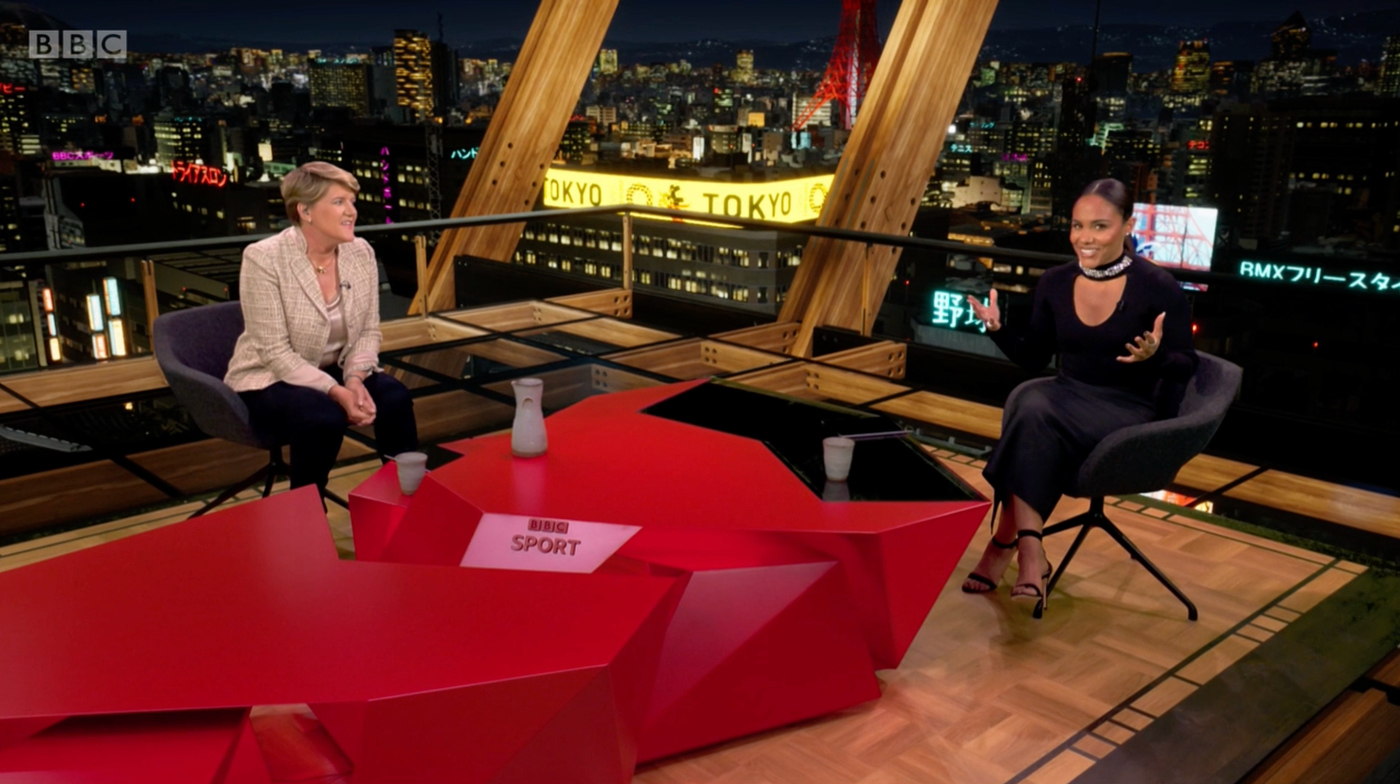

The technology powering the design
A total of 5 cameras were used in the production which consisted of a rail camera, a jib camera and 3 pedestal cameras. On the ceiling were hundreds of reflector stickers that would enable the Mo-sys StarTracker on each camera to provide us with tracking data that would feed into the 5 Brainstorm render engines, one for each camera.
Providing a graphics solution for a major event such as the Olympics is very different to a traditional sports studio presentation.
The Moov solution consisted of Chyron Prime graphics, driven by Orion graphics playout control software. The Virtual Studio solution was powered by Brainstorm’s InfinitySet, and complemented by Epic Games’ Unreal Engine, all running on the latest Nvidia RTX A6000 graphics, and AJA Corvid 88 video cards.
Brainstorm InfinitySet was the centerpiece with Unreal Engine running in the background. This software enabled Moov to control all the incoming video and tracking feeds, apply garbage and dynamic masks to the scene, and add functionality through a web interface so that operators simply had to click buttons to change the scene or animate a screen. Mo-Sys was used for tracking and lens calibration across all cameras which was then managed through the Moov network which enabled us to do clever things with masking.
Blackmagic Design’s Ultimatte was used for keying with excellent results, mainly down to the fantastic lighting department run by Dave Gibson, who in total, must have had hundreds of lighting states for this project.
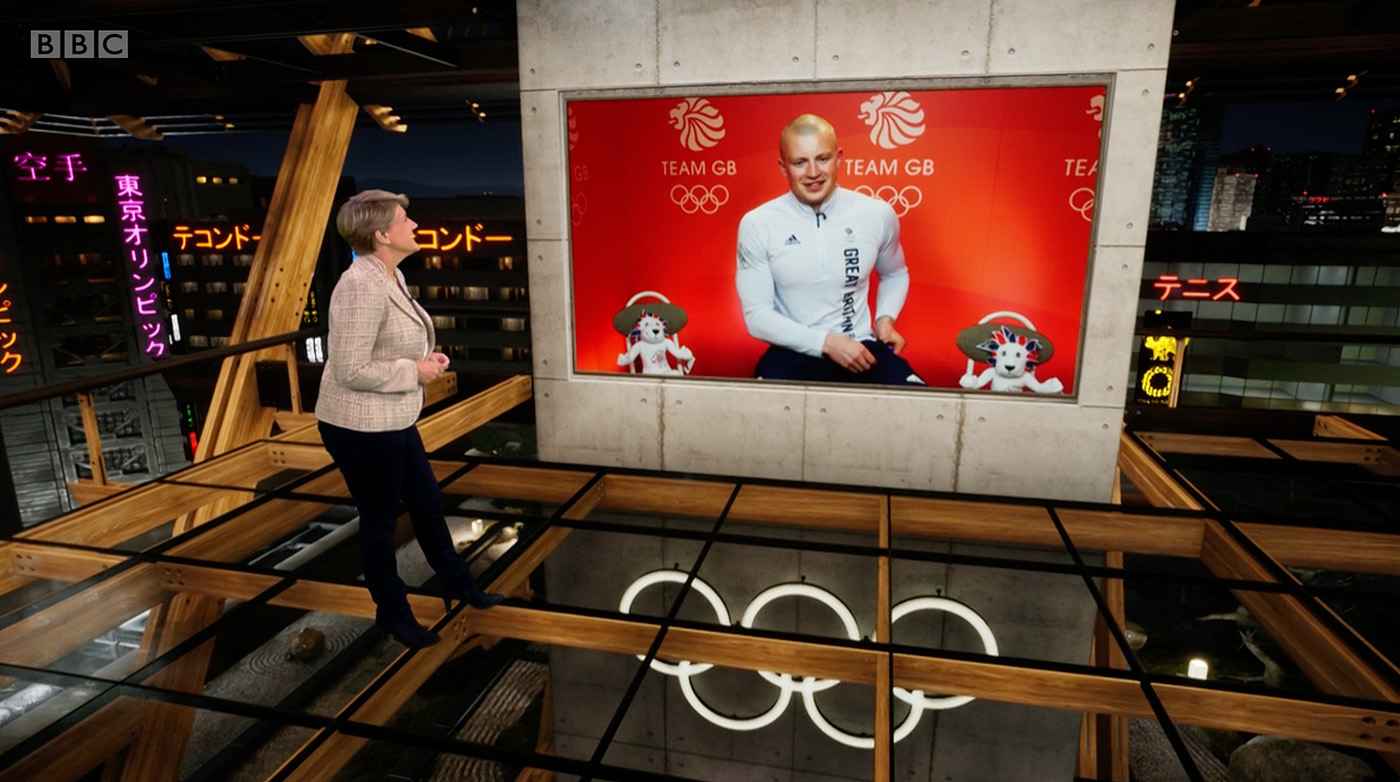

InfinitySet + Unreal leading the way
For the virtual production, Moov took advantage of the latest InfinitySet developments, such as Layers, with which the final composition of background (unreal) and foreground (Camera) was done internally in InfinitySet. The image quality of the camera is not passed through Unreal and therefore the quality of the camera is pixel-accurate. Also, all the eternal feeds were controlled by InfinitySet and then transferred to Unreal Engine.
On top of that, Moov prepared a custom GUI designed internally in InfinitySet and controlled through a WebApp. The layout for the operator was tailor-made exposing not just the regular editors in InfinitySet but also any parameter in Unreal as defined with the Brainstorm Unreal Control application.
The production was effectively on-air 24/7 across the Olympics, with just little gaps in the late evening for just a couple of hours, and, most importantly, the technology really stood up to it, without any fall outs, which is fantastic for that amount of studio output. On top of that, the show received great feedback not only from the industry but also for the audience, proving, once again, that virtual technology is mature enough to cope with any broadcast requirement.
Subscribe to NCS for the latest news, project case studies and product announcements in broadcast technology, creative design and engineering delivered to your inbox.


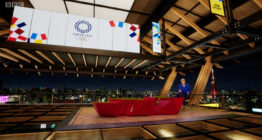



tags
2020 Summer Olympics, AJA Video Systems, BBC Sport, BK Design Projects, Blackmagic Design, Brainstorm 3D, Brainstorm InfinitySet, Brainstorm Multimedia, chyron, ChyronHego, ChyronHego Prime, David Gibson, dock10, Epic Games Unreal Engine, jim mann, lightwell, Mo-Sys, Mo-Sys Engineering, Mo-Sys StarTracker, Moov, Nvidia, Nvidia RTX, Remote Production, Toby Kalitowski, ultimatte, virtual set design, Virtual Sets, Virtual Studio Set, virtual studios
categories
Augmented Reality, Virtual Production and Virtual Sets, Case Study, Sports Broadcasting & Production, Sports Set Design, Virtual Sets, Voices